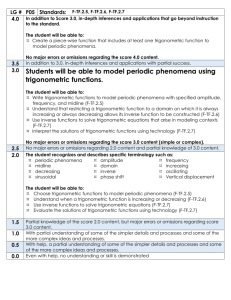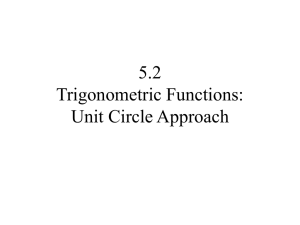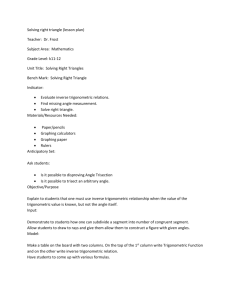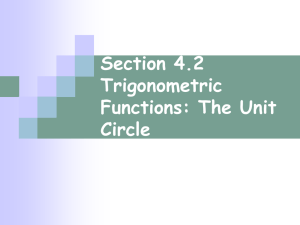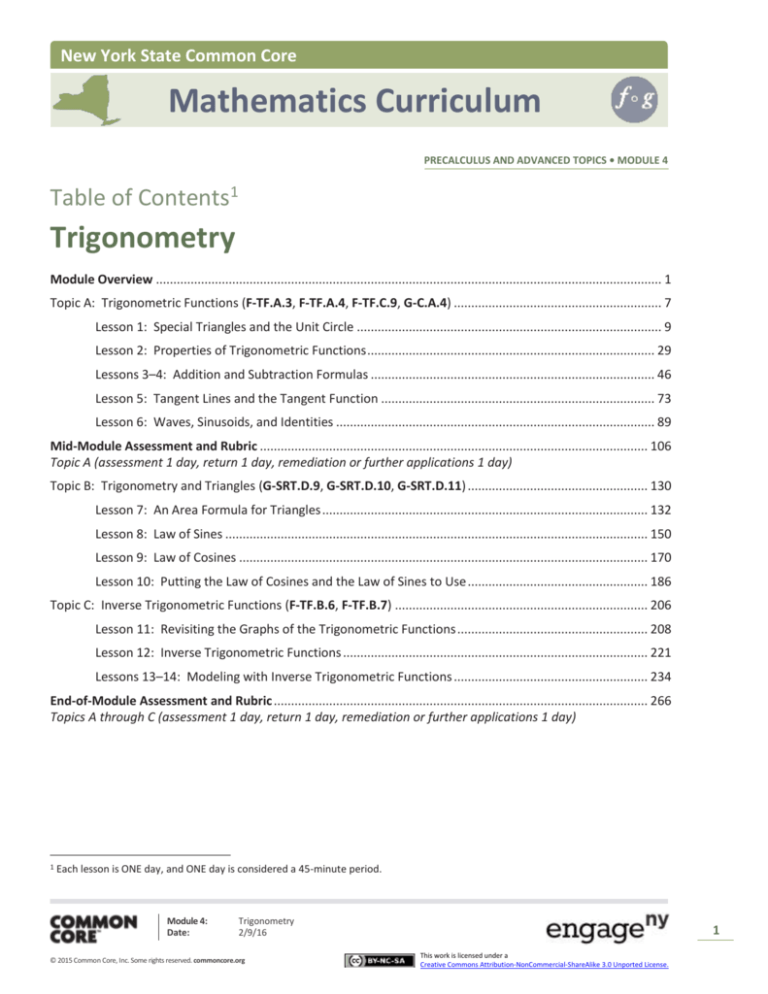
New York State Common Core
Mathematics Curriculum
PRECALCULUS AND ADVANCED TOPICS • MODULE 4
Table of Contents1
Trigonometry
Module Overview .................................................................................................................................................. 1
Topic A: Trigonometric Functions (F-TF.A.3, F-TF.A.4, F-TF.C.9, G-C.A.4) ............................................................ 7
Lesson 1: Special Triangles and the Unit Circle ........................................................................................ 9
Lesson 2: Properties of Trigonometric Functions ................................................................................... 29
Lessons 3–4: Addition and Subtraction Formulas .................................................................................. 46
Lesson 5: Tangent Lines and the Tangent Function ............................................................................... 73
Lesson 6: Waves, Sinusoids, and Identities ............................................................................................ 89
Mid-Module Assessment and Rubric ................................................................................................................ 106
Topic A (assessment 1 day, return 1 day, remediation or further applications 1 day)
Topic B: Trigonometry and Triangles (G-SRT.D.9, G-SRT.D.10, G-SRT.D.11) .................................................... 130
Lesson 7: An Area Formula for Triangles .............................................................................................. 132
Lesson 8: Law of Sines .......................................................................................................................... 150
Lesson 9: Law of Cosines ...................................................................................................................... 170
Lesson 10: Putting the Law of Cosines and the Law of Sines to Use .................................................... 186
Topic C: Inverse Trigonometric Functions (F-TF.B.6, F-TF.B.7) ......................................................................... 206
Lesson 11: Revisiting the Graphs of the Trigonometric Functions ....................................................... 208
Lesson 12: Inverse Trigonometric Functions ........................................................................................ 221
Lessons 13–14: Modeling with Inverse Trigonometric Functions ........................................................ 234
End-of-Module Assessment and Rubric ............................................................................................................ 266
Topics A through C (assessment 1 day, return 1 day, remediation or further applications 1 day)
1
Each lesson is ONE day, and ONE day is considered a 45-minute period.
Module 4:
Date:
Trigonometry
2/9/16
© 2015 Common Core, Inc. Some rights reserved. commoncore.org
1
This work is licensed under a
Creative Commons Attribution-NonCommercial-ShareAlike 3.0 Unported License.
NYS COMMON CORE MATHEMATICS CURRICULUM
Module Overview
M4
PRECALCULUS AND ADVANCED TOPICS
Precalculus and Advanced Topics • Module 4
Trigonometry
OVERVIEW
Trigonometry was introduced in Geometry through a study of right triangles. In Algebra II, work was
conducted on extending basic trigonometry to the domain of all real numbers via the unit circle. This module
revisits, unites, and expands further those ideas and introduces new tools for solving geometric and modeling
problems through the power of trigonometry.
Topic A helps students recall how to use special triangles positioned within the unit circle to determine
geometrically the values of sine, cosine, and tangent at special angles. The unit circle is then used to express
the values of sine, cosine, and tangent for 𝜋 − 𝑥, 𝜋 + 𝑥, and 2𝜋 − 𝑥 in terms of their values for 𝑥, where 𝑥 is
any real number (F-TF.A.3) and to explain the periodicity of the trigonometric functions and their symmetries
(F-TF.A.4). Students develop the addition and subtraction formulas for sine, cosine, and tangent and use
them to solve problems (F-TF.C.9) and to model geometric phenomena. Students also discuss the
construction of tangent lines to circles (G-C.A.4) and revisit the geometric origins of the tangent function.
Student exploration of tangents through a paper folding and compass activity is then used in modeling waves,
waves traveling together, and wave patterns generated by musical instruments.
Students derive sophisticated applications of the trigonometric functions in Topic B including: the area
1
formula for a general triangle, 𝐴 = (2) 𝑎𝑏 sin(𝜃) (G-SRT.D.9), the law of sines, the law of cosines, and
Heron’s formula. They use previous knowledge and apply their understanding of the Pythagorean theorem
and oblique triangles to discover these formulas while analyzing patterns. Finally, as students investigate
force diagrams and paths across rivers, they solve survey and elevation problems and revisit vectors
(G-SRT.D.10, G-SRT.D.11).
The graphs of the trigonometric functions are revisited in Topic C. Students visualize these graphs with the
aid of the appropriate software and briefly recall how changing various parameters of a trigonometric
function affects its graph. Students extend their knowledge of inverse functions to trigonometric functions
(F-TF.B.6) as they restrict domains to create inverse trigonometric functions. These inverse functions are
then used to solve trigonometric equations, evaluate their solutions using technology, and interpret these
solutions in the appropriate contexts (F-TF.B.7). Students determine viewing angle, line of sight, height of
objects, and the angle of elevation for inclined surfaces using inverse trigonometric functions and their
periodic phenomena.
Module 4:
Date:
Trigonometry
2/9/16
© 2015 Common Core, Inc. Some rights reserved. commoncore.org
2
This work is licensed under a
Creative Commons Attribution-NonCommercial-ShareAlike 3.0 Unported License.
Module Overview
NYS COMMON CORE MATHEMATICS CURRICULUM
M4
PRECALCULUS AND ADVANCED TOPICS
Focus Standards
Extend the domain of trigonometric functions using the unit circle.
F-TF.A.3
(+) Use special triangles to determine geometrically the values of sine, cosine, tangent for
𝜋/3, 𝜋/4, and 𝜋/6, and use the unit circle to express the values of sine, cosines, and tangent
for 𝜋 − 𝑥, 𝜋 + 𝑥, and 2𝜋 − 𝑥 in terms of their values for 𝑥, where 𝑥 is any real number.
F-TF.A.4
(+) Use the unit circle to explain symmetry (odd and even) and periodicity of trigonometric
functions.
Model periodic phenomena with trigonometric functions.
F-TF.B.6
(+) Understand that restricting a trigonometric function to a domain on which it is always
increasing or always decreasing allows its inverse to be constructed.
F-TF.B.7
(+) Use inverse functions to solve trigonometric equations that arise in modeling contexts;
evaluate the solutions using technology, and interpret them in terms of the context.★
Prove and apply trigonometric identities.
F-TF.C.92
(+) Prove the addition and subtraction formulas for sine, cosine, and tangent and use them
to solve problems.
Understand and apply theorems about circles.
G-C.A.4
(+) Construct a tangent line from a point outside a given circle to the circle.
Apply trigonometry to general triangles.
G-SRT.D.9
(+) Derive the formula 𝐴 = 1/2𝑎𝑏 sin(𝐶) for the area of a triangle by drawing an auxiliary
line from a vertex perpendicular to the opposite side.
G-SRT.D.10 (+) Prove the Laws of Sines and Cosines and use them to solve problems.
G-SRT.D.11 (+) Understand and apply the Law of Sines and the Law of Cosines to find unknown
measurements in right and non-right triangles (e.g., surveying problems, resultant forces).
Foundational Standards
Extend the domain of trigonometric functions using the unit circle.
F-TF.A.1
2
Understand radian measure of an angle as the length of the arc on the unit circle subtended
by the angle.
Students are now responsible for proofs of angle addition and subtraction formulas.
Module 4:
Date:
Trigonometry
2/9/16
© 2015 Common Core, Inc. Some rights reserved. commoncore.org
3
This work is licensed under a
Creative Commons Attribution-NonCommercial-ShareAlike 3.0 Unported License.
Module Overview
NYS COMMON CORE MATHEMATICS CURRICULUM
M4
PRECALCULUS AND ADVANCED TOPICS
F-TF.A.2
Explain how the unit circle in the coordinate plane enables the extension of trigonometric
functions to all real numbers, interpreted as radian measures of angles traversed
counterclockwise around the unit circle.
Model periodic phenomena with trigonometric functions.
F-TF.B.5
Choose trigonometry functions to model periodic phenomena with specified amplitude,
frequency, and midline.★
Prove and apply trigonometric identities.
F-TF.C.8
Prove the Pythagorean identity sin2 (𝜃) + cos2(𝜃) = 1 and use it to find sin(𝜃), cos(𝜃), or
tan(𝜃) given sin(𝜃), cos(𝜃), or tan(𝜃) and the quadrant of the angle.
Understand the concept of a function and use function notation.
F-IF.A.1
Understand that a function from one set (called the domain) to another set (called the
range) assigns to each element of the domain exactly one element of the range. If 𝑓 is a
function and 𝑥 is an element of its domain, then 𝑓(𝑥) denotes the output of 𝑓
corresponding to the input 𝑥. The graph of 𝑓 is the graph of the equation 𝑦 = 𝑓(𝑥).
F-IF.A.2
Use function notation, evaluate functions for inputs in their domains, and interpret
statements that use function notation in terms of a context.
Analyze functions using different representations.
F-IF.C.7
Graph functions expressed symbolically and show key features of the graph, by hand in
★
simple cases and using technology for more complicated cases.
e.
Graph exponential and logarithmic functions, showing intercepts and end behavior,
and trigonometric functions, showing period, midline, and amplitude.
Build new functions from existing functions.
F-BF.B.4
Find inverse functions.
a.
Solve an equation of the form 𝑓(𝑥) = 𝑐 for a simple function 𝑓 that has an inverse
and write an expression for the inverse. For example, 𝑓(𝑥) = 2𝑥 3 or
𝑓(𝑥) = 𝑥 + 1⁄𝑥 − 1 for 𝑥 ≠ 1.
b.
(+) Verify by composition that one function is the inverse of another.
c.
(+) Read values of an inverse function from a graph or table, given that the function
has an inverse.
d.
(+) Produce an invertible function from a non-invertible function by restricting the
domain.
Module 4:
Date:
Trigonometry
2/9/16
© 2015 Common Core, Inc. Some rights reserved. commoncore.org
4
This work is licensed under a
Creative Commons Attribution-NonCommercial-ShareAlike 3.0 Unported License.
Module Overview
NYS COMMON CORE MATHEMATICS CURRICULUM
M4
PRECALCULUS AND ADVANCED TOPICS
Define trigonometric ratios and solve problems involving right triangles.
G-SRT.C.6
Understand that by similarity, side ratios in right triangles are properties of the angles in the
triangle, leading to definitions of trigonometric ratios for acute angles.
G-SRT.C.7
Explain and use the relationship between the sine and cosine of complementary angles.
G-SRT.C.8
Use trigonometric ratios and the Pythagorean Theorem to solve right triangles in applied
problems.★
Understand and apply theorems about circles.
G-C.A.2
Identify and describe relationships among inscribed angles, radii, and chords. Include the
relationship between central, inscribed, and circumscribed angles; inscribed angles on a
diameter are right angles; the radius of a circle is perpendicular to the tangent where the
radius intersects the circle.
Prove geometric theorems.
G-CO.C.10
Prove theorems about triangles. Theorems include: measures of interior angles of a triangle
sum to 180°; base angles of isosceles triangles are congruent; the segment joining midpoints
of two sides of a triangle is parallel to the third side and half the length; the medians of a
triangle meet at a point.
Focus Standards for Mathematical Practice
MP.3
Construct viable arguments and critique the reasoning of others. Students construct
mathematical arguments as they explain their calculations of the area of triangles leading to
1
a new formula for area, Area = 2 𝑏𝑐 sin(𝜃). Students explain the properties of
trigonometric functions and explain construction of tangent lines. Students use the periodic
nature of trigonometric functions to reason about their graphs and problem solve using
inverse functions.
MP.4
Model with mathematics. Students apply sum and difference formulas in the context of
modeling sound waves using trigonometric functions. Students model using trigonometric
functions applying tangent lines and Law of Sines and Cosines to solve surveying problems
and revisit vectors. Students investigate viewing distance, line of sight, and viewing angle
using inverse trigonometric functions as well as the angle of elevation for inclined surfaces.
MP.5
Use appropriate tools strategically. Students see the unit circle as a tool to determine the
values of trigonometric functions in terms of 𝑥 and explain their periodicity and symmetry.
Students use computer software and graphing calculators to graph trigonometric functions
and their inverses. Students see trigonometric inverses, Law of Sines, Law of Cosines, and
area formulas as tools in problem solving.
Module 4:
Date:
Trigonometry
2/9/16
© 2015 Common Core, Inc. Some rights reserved. commoncore.org
5
This work is licensed under a
Creative Commons Attribution-NonCommercial-ShareAlike 3.0 Unported License.
Module Overview
NYS COMMON CORE MATHEMATICS CURRICULUM
M4
PRECALCULUS AND ADVANCED TOPICS
Terminology
Familiar Terms and Symbols3
Sine
Cosine
Tangent
Function
Radian Measure
Tangent Line
Unit Circle
Period
Vector
Suggested Tools and Representations
Compass
Straightedge
Graphing Calculator
Wolfram Alpha Software
Geometer’s Sketchpad Software
GeoGebra software
Assessment Summary
3
Assessment Type
Administered Format
Standards Addressed
Mid-Module
Assessment Task
After Topic A
Constructed response with rubric
F-TF.A.3, F-TF.A.4,
F-TF.C.9, G-C.A.4
End-of-Module
Assessment Task
After Topic C
Constructed response with rubric
F-TF.B.6, F-TF.B.7,
G-SRT.D.9, G-SRT.D.10,
G-SRT.D.11
These are terms and symbols students have seen previously.
Module 4:
Date:
Trigonometry
2/9/16
© 2015 Common Core, Inc. Some rights reserved. commoncore.org
6
This work is licensed under a
Creative Commons Attribution-NonCommercial-ShareAlike 3.0 Unported License.


